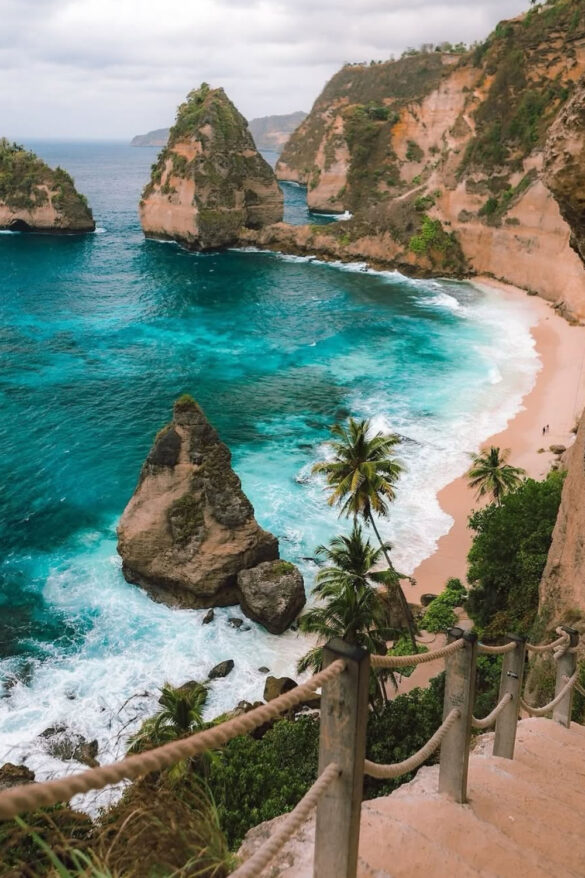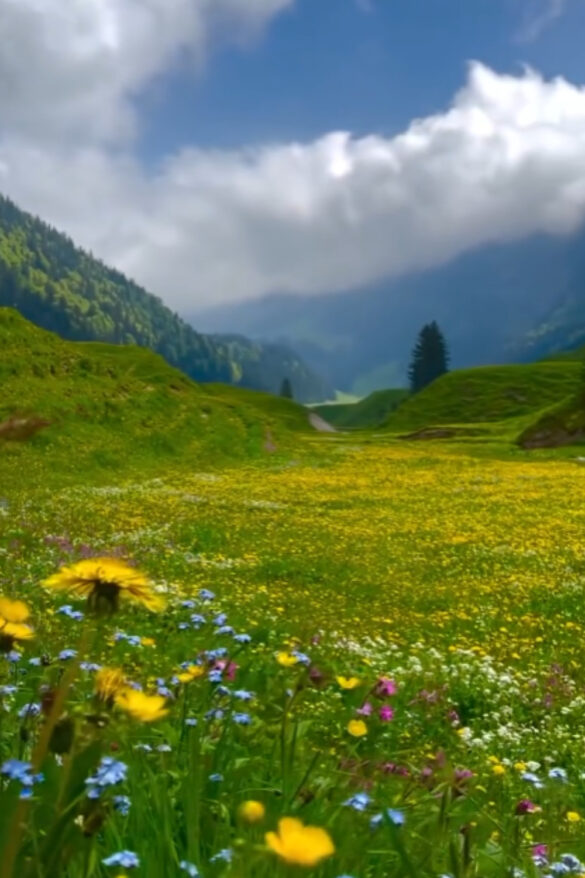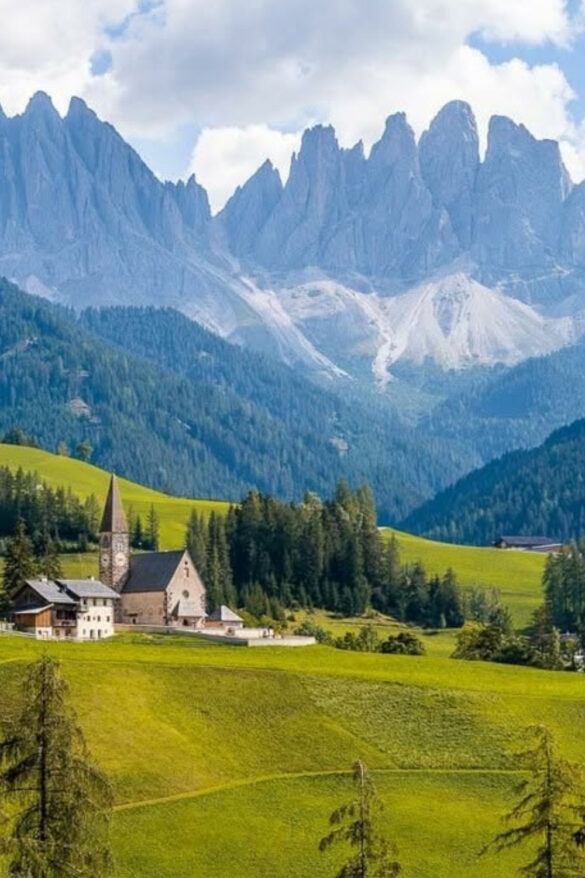Introduction: Beyond the Obvious: Discovering Europe’s Best-Kept Secrets
What do you think of when you think of European vacation? Is it the Eiffel Tower glittering in Paris, the old Colosseum in Rome or the busy London streets? These stereotypical destinations are truly spectacular and definitely worthy of exploration, but Europe is a continent of enormous variety and multifaceted Ness and there is a treasure trove of lesser-known destinations that are equally, and in some ways more, fascinating. These are the so-called hidden gems, where it is possible to avoid the tourist crowd, experience the original local culture and find out the best secrets of the continent. By going off the beaten road, one can experience the travel experience in a much more personal and deeper way, and one that is usually full of unexpected surprises and authentic experiences.
The post is an informative blog about a new type of European adventure, one that cannot be found on the postcards and tours. We have created a list of 7 hidden gems in Europe that should be added to your bucket list each with its unique charm and memorable experience. Whether it is a remote island archipelago or an ancient town in the mountains, these are the destinations that will amaze and impress even the most experienced traveler. We will take an extensive tour of each of these places to give a detailed description of their history, culture and exotic attractions. Then start broadening your travel horizons and see another side of Europe that the majority will never see. It is not some kind of a travelling guide, it is an invitation to the unusual.

1. North Atlantic drama: The Faroe Islands.
The Faroo Islands, an archipelago of 18 large islands in the center of the North Atlantic, between Iceland and Norway, are the real definition of the term hidden gem. This independent state of the Kingdom of Denmark is another world where picturesque landscapes, extraordinary culture, and the overwhelming feeling of peace come together. Crowded beaches and busy urban centres are nothing compared to the Faroes, with their precipitous crashes of sea cliffs, sweeping down into the churning sea depths, green glacial valleys and pretty villages hanging precariously upon the hill-tops. Weather here is notoriously unpredictable, and changes rapidly between beautiful sunshine and thick fog, which only contribute to the mystical charm of the islands. The land, and the strong folk who have grown in this ever-changing environment, have moulded a culture with a deep attachment to the sea and what it produces.
Another perspective into the Faroese Life:
The Faroe Islands are geological marvels: The Faroe Islands are primarily composed of volcanic basalt layers, so that they appear to have been stepped on. These layers have been carved into magnificent fjords, sea stacks and grottoes by the mighty forces of glaciation and erosion. The best example would certainly be the Drangarnir sea stack and the Mulafossur waterfall, which is a really iconic picture of the islands. A boat trip to the Vestmanna Sea Cliffs provides an amazing view of these giant rock structures and the thriving bird population that resides in the rocky gaps.
- Special Ecosystems and Wildlife: remote location of the Faroe Island has led to the establishment of a special ecosystem. It has been home to a lot of birdwatching because there is plenty of birdlife due to the absence of natural predators. On the cliffs puffins, guillemots, and fulmars nest by thousands. Whales, dolphins and seals are found in the surrounding waters. Sheep, which outnumber the human population, are part of the landscape and economy, and serve as the source of the well-known wool products of the islands.
- Faroese Culture and Language: Faroese people have their own culture and North Germanic language, Faroese, the closest sister of the Icelandic and old Norse. This is an example of their Viking roots through the language. The cultural component of the Faroese culture is the traditional chain dancing with ballads (kvæði). The capital, Torshavn, may be small in size, but has museums, art galleries, and some of the best restaurants serving local produce, especially fresh seafood.
- The Faroe Islands believe in sustainable tourism: the country strives to conserve their clean environment and culture. Campaigns such as the “Closed for Maintenance, Open for Voluntourism” are encouraging tourists to come and assist in repairing hiking paths and facilities. In this way, the islands will be a clean getaway destination by the new generations. Through your visit, you are not necessarily a tourist, but you find yourself having direct interactions with the surrounding natural environment and community.
- Why It Needs to Be on Your Bucket List: The Faroe Islands are a place that is hard to find when one wants to escape the ordinary. It is a soul place, a place where you are able to connect with the splendor of nature fully. Visualize walking up and down ancient tracks, inhaling fresh and clean air, and observing the sceneries that look like they belong in a different world. This feeling of solitude and wonder is possibly the best part of it which is why it makes the list of the top hidden gems in Europe you must see.
2. Olomouc, Czech Republic: A Baroque Masterpiece Without the Crowds
Though Prague is justifiably known to millions as the city of fairytale castles and the Bridge, it is only an hour or so more to the east that one finds a city as extraordinary in its historical richness and architectural majesty as Prague, only to be left off the tourist list by a handful of tourists. This is what qualifies it to be included in our list of 7 hidden gems in Europe that you must add to your bucket-list. Olomouc was the old capital of Moravia and a large center of religious and cultural life. You can see its rich past in its very well-preserved Baroque architecture, its quaint squares, and a kind of air of history that surrounds every cobblestone street. Olomouc is a less hectic, more natural Czech experience than Prague, so when you visit there you can fully appreciate the beauty of the place and explore its rich cultural heritage without the constant side effects of large numbers of people.
Unveiling Olomouc’s Riches:
- Holy Trinity Column: A UNESCO World Heritage Site: The greatest treasure of Olomouc is, no doubt, the Holy Trinity Column in Horni namaesti (Upper Square). The largest of its kind in Central Europe, this great Baroque monument was constructed in the years 1716 to 1754 and is a UNESCO World Heritage site. Its vastness, elaborate sculptural decoration and the strength of religious symbolism it bears, honoring God because it has finally put an end to a plague, are indeed awe-inspiring. It is more than 35 meters high and has many religious sculptures, such as gilded copper images of the Holy Trinity and Assumption of the Virgin Mary, and 12 images of saints. Not only is it a monument, but it is a monument of the artistic and spiritual passion of its time.
- Architectural splendor and Squares: There are two gorgeous primary squares in Olomouc, outside of the Holy Trinity Column: Horni namesti and Dolni namesti (Lower Square). These are squares edged with fine burgher houses, old fountains, and busy cafes. The fountains of the city are no exception, as a lot of them are also Baroque, showing Roman gods and heroes, including the Hercules Fountain and the Caesar Fountain, the latter being a representation of the legendary founder of the city Julius Caesar. Two other buildings that make the city aesthetically attractive are the st. Wenceslas Cathedral and its great spires, and the Archbishops Palace which is a good example of the Baroque style.
- Thick History and Educational Center: Olomouc is a city with a rich history. It was a significant ecclesiastical seat, and the seat of one of the oldest Czech national universities Palacky University, founded in 1573. This great expenditure on the study-life gives to the city a youth and vigor which contributes to its vigor of cafe-life and its dialectic atmosphere. A hint of the history and religious art of the region is provided by the Archdiocesan Museum of the Olomouc Castle.
- Local Gastronomy: Olomoucké tvarůžky: No sightseeing trip to Olomouc can be complete without trying the most popular local specialty: Olomoucké tvarůžky. Produced in the region for centuries and having a Protected Geographical Indication designation, the soft cheese with its unique strong smell and low fat content is a creation that has centuries of history. It can be taken with bread, onion and beer, giving a very genuine taste of Moravia.
Why it should be added to your Bucket List: Olomouc has such a stunning cultural and historical experience without the flood of tourists. It is an area where you can take your time and explore the secret gardens, and enjoy the feel of a genuine Czech city. Olomouc is one of the top contenders in the list of hidden gems in Europe that you should place on your bucket list because of its rich history, architecture, and slow rhythm of the travel experience. It is a statement of how some most beautiful encounters in Europe are on the fringes.

3. Ghent, Belgium: Where Medieval Grandeur Meets a Modern Vibe
Bruges might have seized the romantic imaginations of the traveller, but its more obscure neighbor Ghent, can afford an equally picturesque, and perhaps more natural, Belgian experience. A city in which the past does not only exist as a well-preserved object, but also as an inhaling, breathing spirit of the present, Ghent is a lively, busy university town, unobtrusively uniting an ancient medieval tradition with a modern, imaginative spirit of the present. Consequently it has rightly found its place on our list of 7 hidden gems in Europe that you must put on your bucket list. The old centre of the city is the masterpiece of Gothic and Baroque architecture, and it is the paradise of the pedestrian because it does not have the crowds of tourists that usually fill its Flemish equivalents. This gives the opportunity to explore in more intimate detail its beautiful canals, old guildhalls and classic three towers, which shape the unique skyline of the city.
The Beauty of Ghent–A Closer Look:
- A City of Three Towers and a Dragon: The Ghent skyline is known to feature three medieval towers: the Belfry of Ghent, the Cathedral of St. Bavo and the Church of St. Nicholas. This three-piece architectural wonder is an effective reminder of the past prosperity and self-sufficiency of the city. The Belfry is a UNESCO World Heritage site, and there is a golden dragon that is placed on top of the structure, to represent the rebellion and liberation of the city. The Belfry is a very nice place to climb up the Belfry itself, and look down the city with its red roofs and waterways and old-fashioned plazas.
- So, what other castles are perched upon a hill, the Gravensteen, or Castle of the Counts is a mighty fortress that was simply dropped in the middle of the town. Constructed by Philip of Alsace, Count of Flanders, in 1180 not only was it designed to defend the city but also to scare the infamously disobedient people of the city. Nowadays you can wander around its frozen battlements, a torture chamber (complete with bloodthirsty displays) and a keep and have an entertaining and informative audio guide tell the long and occasionally dark history of the place.
- Artistic and Culinary Treasures: The Cathedral of St. Bavo features one of the most powerful and important artworks in Europe, the Ghent Altarpiece, or The Adoration of the Mystic Lamb, by Hubert and Jan van Eyck. This is the polyptych of the Northern Renaissance of the 15th century, and a very interesting story of theft and restoration. A tour of the cathedral and its altarpiece is an immersion in the history of art. In addition to its artistic riches, Ghent is a gastronomic paradise, especially in the vegetarian world and local delicacies, such as Waterzooi (creamy stew of chicken or fish) and the traditional cone-shaped candies, cuberdonds.
- A Young and Hip Hop Heartbeat: Ghent just has a young, vibrant vibe that is unique to it. Being a big university town, the city is full of life, including its busy squares, such as Korenmarkt and Graslei, and its well-kept street art alleys, such as Werregarenstraatje. The contrast between the old and the new population of students and local people brings out an energetic vibe. It is not a place which is trapped in the past, it is a city where the past and modern life live together in a perfect harmony.
• Why It Makes Your Bucket List: Ghent is both an idyllic small-town in Flanders and a vibrant European metropolis. It is less busy and cheaper than its well-known neighbor, and it will be possible to have real communication with local culture. Ghent is a city with a soul, beauty, and a story to tell, and it makes it a true contender among the most rewarding hidden gems in Europe that you must put on your bucket list.
4. Sintra Portugal: Fairy tale in the Hills.
Sintra, just a simple train ride away from the capital of Lisbon, in Portugal, feels as though it has sprung right out of a fairytale book. This magical town, with its gilded palaces, its mysterious gardens, its thick, foggy forest, is nestled in the midst of the fertile hills of the Serra de Sintra, and seems to be shrouded in an unremitting veil of mystery. Although a UNESCO World Heritage site, it is a well-kept secret in the sense that most travelers dedicate a day trip and do not get the chance of experiencing all the magic the place has to offer. By taking more time you can explore the quieter areas and little-known historical locations that make it a much more immersive experience, which is why it merits a place on our list of 7 hidden gems in Europe you should make sure to add to your bucket list. The combination of romanticism, fantasy, and history that is specific to Sintra can be found nowhere in the continent.
Exploring the Magic of Sintra:
- Pena Palace: Romanticist Masterpiece: The most recognizable building in Sintra is the Pena Palace, a fanciful and vibrant masterwork sitting on the top of the Penha de Sintra Mountain. This palace, commissioned by King Ferdinand II in the middle of the 19th century, is a vivid display of Romanticism, a combination of architectural styles, such as Neo-Gothic, Neo-Manueline, Neo-Islamic and Neo-Renaissance. Bright, fantastical colors and decorative features create an impression of a dream, contrasts with the rest of the natural environment. The position of this palace offers great scenic views of the green park beneath and the Atlantic Ocean in the far left.
- Quinta da Regaleira: A Mystical Wonderland: If you like a touch of the esoteric, Quinta da Regaleira is a place you cannot afford to miss. This beautiful property constructed by this strange millionaire António Carvalho Monteiro is a maze of mysterious symbols, underground tunnels, and hidden paths. The Initiation Well is at the top and is a spiraling staircase to the depths of the earth symbolizing re-emergence into the spiritual world. The estate gardens are also crowded with grottos, waterfalls, architectural follies and the feeling of adventure and exploration is very specific to reproduce.
- Ancient Castle of the Moors: On top of a rocky crag, the ruins of the Castle of the Moors are the stark reminder of the ancient past of Sintra. The Moors constructed this fortress in the 8th and 9th centuries, and it provides a dramatic contrast to the fancy palaces located down below. Walking its old stone walls offers incomparable panorams of the adjacent woods and the palaces and makes you feel the strategic and historical significance of Sintra. There is an overlay of traveling back in time here.
- Lush Sintra-Cascais Natural Park: Sintra is not only the palaces, it is also the Sintra-Cascais Natural Park. The microclimate of the area, which is often misty and humid, has formed a thick and green forest with exotic plant species. Such a special atmosphere creates the impression that even a walk across the area is reminiscent of a stroll through an enchanted forest with tree moss, a quiet and damp silence.
• Why It Should Be On Your Bucket List: Sintra is the place of imagination and soul. You can get lost there in history, mythology, and nature. You can take your time, discover the secret paths and fully enjoy the stratifications of history and fantasy that make it so special by staying longer than a day. It is an ideal example of a destination which is well known yet there is so much left to be explored and it is one of the most mysterious secrets within the European continent that deserves to be listed on your bucket list.
5. Matera, Italy: The City Carved from Rock
When the vast majority of people think about Italy they think about the art-street Florence or the ancient ruins of Rome. But, hidden in the southern part of Basilicata, there is the city of Matera that breaks all these expectations and gives a travel experience that has never been experienced before. Matera is a living, breathing monument to the survival and resourcefulness of human beings, known as its cave dwellings or Sassi, a UNESCO World Heritage site. These caves had been inhabited by some of the poorest of the poor in Italy, a land of misery and neglect, for centuries. The miracle of Matera, today, is that its Sassi has been turned into boutique hotels, restaurants and art galleries, and is thus an interesting and dramatic addition to our list of 7 hidden gems in Europe that you should add to your bucket list.
A Travelling in Time in Matera:
- The Sassi: A glimpse into the past: the Sassi of Matera: a system of ancient cave houses, cut into the soft tuf of a deep ravine. Matera is one of the oldest continuously inhabited cities in the world as these caves have been inhabited continuously over 9,000 years. Sassi is a word that means stones, and it is used to refer to the two major districts Sasso Barisano and Sasso Caveoso. The natural, gorgeous architecture is due to the generations of people who hacked their homes, churches, and open spaces right out of the rock face. This distinctive city scenery acted as a strong representation of the poverty in Italy until the 1950s when the government transported the inhabitants elsewhere.
- The Story of a Miraculous Makeover: Shame to Pride: The transformation of Matera as an Italian shame town into an Italian cultural capital is an incredible narrative of rebirth. The Sassi remained a derelict area decades after the forced evacuation. But a grassroots campaign in the 1980s brought a new vision, and residents and entrepreneurs undertook to conserve and redevelop the area. The result of this renewal was Matera becoming a European Capital of Culture in 2019, an official designation that placed it squarely on the map. Rebirth of the city is a wonderful sustainable tourism and cultural conservation philosophy.
- Cinematic Backdrop and Spiritual Tranquility: The dramatic, ancient Matera Landscape has been the location of dozens of films, most infamously The Passion of the Christ by Mel Gibson who took advantage of the similarity between Matera and ancient Jerusalem. In addition to the cinematic popularity, Matera is also the location of over 150 rock churches, or chiese rupestri, most of which also harbor gorgeous frescoes left behind by the Byzantine period. Two particularly elaborately carved churches are Santa Maria de Idris and San Pietro Barisano, and their history.
- Exceptional Sensory Experience: Paying a visit to Matera is a sensory experience. You will lose yourself in its twisting alleys and steps, and touch the cool stone walls, and hear the echoes of history. Night comes, and the city lights, and the cave dwellings illuminate the landscape warmly and magically… a sight to remember. Eating at a cave restaurant or spending the night in a cave hotel gives you a firsthand experience of the history of the city, and turns an otherwise ordinary stay into a history lesson.
• Why It Should Be on Your Bucket List: Matera is a great contrast to other Italian cities that are more popular. It is one of the places where you can stare directly back in time and to see the power of people. The city is truly a one-of-a-kind place in terms of its distinctive architecture, its fascinating history of resurgence, and its spiritual environment. Matera isn’t one of the key European hidden gems that you must put on your list of places to visit, but it is definitely worth considering to those who are interested in authenticity and a strong sense of place.
6. Colmar, France: Peterselndorf Alsace.
When most tourists head to Paris and the sun-soaked French Riviera, another interesting place to visit lies in the North Eastern part of Alsace. Here, halfway between the Vosges and the Rhine, is Colmar, a town so pretty that it looks like it came right out of a nursery book. It is a true hidden treasure, as well as a worthy entry in our list of 7 hidden gems in Europe you must add to your bucket list, thanks to its perfectly preserved medieval and early Renaissance architecture, including half-timbered houses painted in bright colors. Colmar is a very unusual blend of French and German cultures due to its unsettled history, which can be seen in the culture, food, and language.
Exploring the Charms of Colmar:
- A Colorful Feast for the Eyes: The first thing that comes to mind when you look at Colmar is how beautiful it is. The old core of the town looks like a rainbow of different colors because houses are timber-framed and are painted in pink, yellow, blue and green color. It is easier to see than to describe, and the best way to enjoy this visual treat is just to wander around its cobblestone lanes. It is especially lovely around the so-called Little Venice (La Petite Venise), where a canal passes through the flowerbeds and colourful houses, creating a peaceful and romantic atmosphere on a boat ride. Butchers, fishmongers and tanners had made their home in this area and the canals were used to transport goods.
- A Tour of History and Art: Colmar is a pretty face, but it is also a city of art and history. The Unterlinden Museum is located in an old Dominican convent. It houses a great masterpiece of the German Renaissance, the Isenheim Altarpiece, by Matthias Grunewald and Niclaus of Haguenau. One can also see the whole artistic tradition of the area and the ancient and modern art of the museum as well. There is also the Bartholdi Museum, honoring the most renowned son of the town, sculptor Fr Frederic Auguste Bartholdi, creator of the Statue of Liberty.
- The Heart of the Alsace Wine Route: Colmar is commonly known as the Capital of the Alsatian Wines. It is on the Alsace Wine Route which is a trail along the villages and vineyards. White wines, especially Riesling, Gewurztraminer and Pinot Blanc are very famous in the region. It can be tasted (and even given a tour) in the local wine cellars (or caves) which will be very fine in case somebody would like to know peculiarities of terroir in the place. This combination of both German and French winemaking tradition and French sophistication make the white wines produced some of the most aromatic and complex in the world.
- A Cultural Identity of its own: The character of Colmar is defined by its French-German dual identity. Some of the locals still use the Alsatian dialect of German, and the cuisine includes a fine blend of both cultures, with hearty choucroute (sauerkraut) on one end and delicate tarte flambée (flame-grilled tart) on the other end. This cultural, two-sidedness is a part and parcel of the beauty of Colmar. Christmas market is also one of the most popular in France and it makes the streets of the town turn into winter wonderland.
• Why It Should Be On Your Bucket List: Colmar is a place where you can escape into a fairytale land without the pretense and huge crowds of the other popular places in Europe. Exceptionally maintained architecture, rich cultural diversity, and vibrant atmosphere make it an ideal place where people can find beauty, history and some magic. Colmar is one of the most memorable under-the-radar destinations on the continent that you must include on your bucket list.
7. Hallstatt, Austria: A Lakeside Village of Unparalleled Beauty
Between the dramatic Dachstein mountains and the serene Hallstätter See (Lake Hallstatt), Hallstatt, Austria, seems to be a destination that is too good to be true. The steep mountains and deep lake have kept this small, postcard-perfect village a hidden treasure over centuries. Its scenic beauty has since become a social media celebrity in recent years, but it has not lost its underlying charm and history that has made it unique. It is the old age and its own traditions as well as the beautiful surrounding nature that makes Hallstatt an ideal ending to our list of 7 hidden gems in Europe that you must add to your bucket list.
As of the Essence of Hallstatt:
- An Ancient History Forged in Salt: Salt was the single most valuable commodity, upon which the wealth of Hallstatt and its significance were founded. There is the oldest salt mine in the world, found above the village, over 7,000 years old. This prehistoric trade drove the history of Hallstatt and even its name, which is based upon the Celtic word of salt. The mine can be explored on an interesting tour, reached by a funicular railway, and includes some fascinating rides on wooden slides that have been in use since the time of the miners. Another viewing platform at the top is the Hallstatt Skywalk that provides sweeping views of the village, the lake, and the mountains.
- Architecture and a Special Cemetery: Since the village is located on a very narrow piece of land the timber houses are constructed on the steep side of the mountain piled one above the other forming an unusual and adorable landscape. The small space also gave rise to a very interesting and gloomy custom. The cemetery in the locality is so small that over centuries the graves were reused. The bones were exhumed, whitened in the sun, and decorated with patterns of flowers and the names of the dead and kept in the Bone House (Beinhaus) in St. Michael Chapel. It is a fearsome evocation of the past and the ingenuity of the village, now less common than it used to be.
- A Lakeside Retreat: the beauty of Hallstatt is also closely connected with its location on the lake. The village is a mirror of the mountains around and the whole village is reflected in the still water, forming a fascinating image. Tours of the lake by boat provide an alternative view of the village, and when the weather is warm visitors may hire small electric boats and sail around the peaceful waters. The village is most agreeable in the early morning or late evening, when the day-trip travelers have cleared, and a deep feeling of calm pervades.
• Why It Should Be on Your Bucket List: Hallstatt is a place that you fall in love with. It is an immensely satisfying experience with a rich industrial history, distinctive cultural traditions, and incomparable natural beauty. Although this could be more common knowledge now, by going to Hallstatt and staying there you can strip it down to reveal the silent magic that made it a legend. Hallstatt is a wonderful specimen of one of the best hidden secrets in Europe that you must add to your list of places to visit.

Conclusion
Europe has long had her trite routes, and the real charm of travelling is to find the unheard of. This is a challenge to leave the well-trodden trail and create your own path, hence this list of 7 hidden gems in Europe you must add to your bucket list. Ranging across the wilderness of the Faroe Islands and historical majesty of Olomouc to the artistic vibe of Ghent and the fairytale sceneries of Sintra, Matera, Colmar and Hallstatt, these places will make the journey memorable. A tribute to the rich and varied tapestry of the continent, they provide an opportunity to relate to history, culture and nature in a manner that the standard tourist trail just cannot. Therefore, get on it, revise that list of current places of interest, and get ready to explore the Europe that hardly anybody gets to see.
References:
- Hallstatt Tourism Office: (www.hallstatt.net)
- Salzwelten Hallstatt: Salt Mine Tours. (www.salzwelten.at/en/hallstatt)
- “Hallstatt: A Cultural Journey” by Dr. Anton Fux.
- UNESCO World Heritage Centre: Hallstatt-Dachstein / Salzkammergut Cultural Landscape. (https://whc.unesco.org/en/list/806/)





